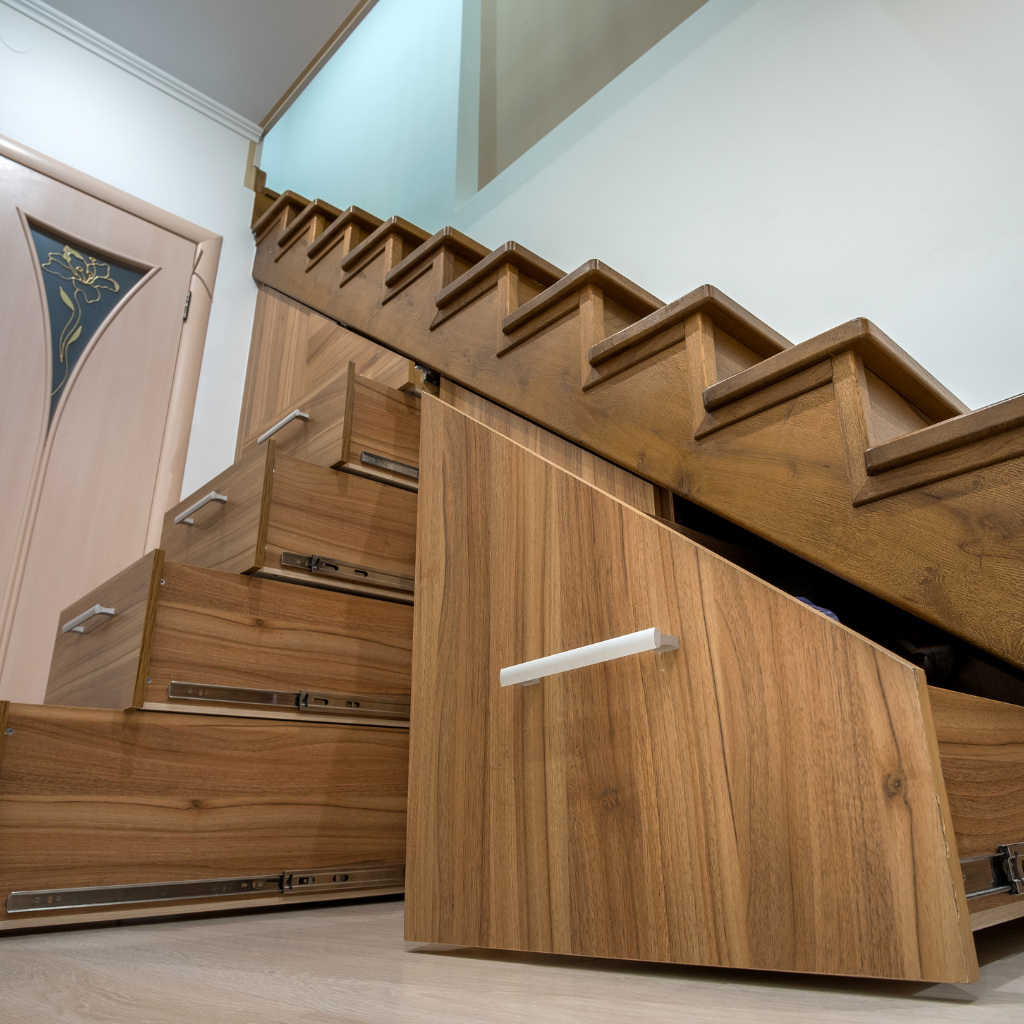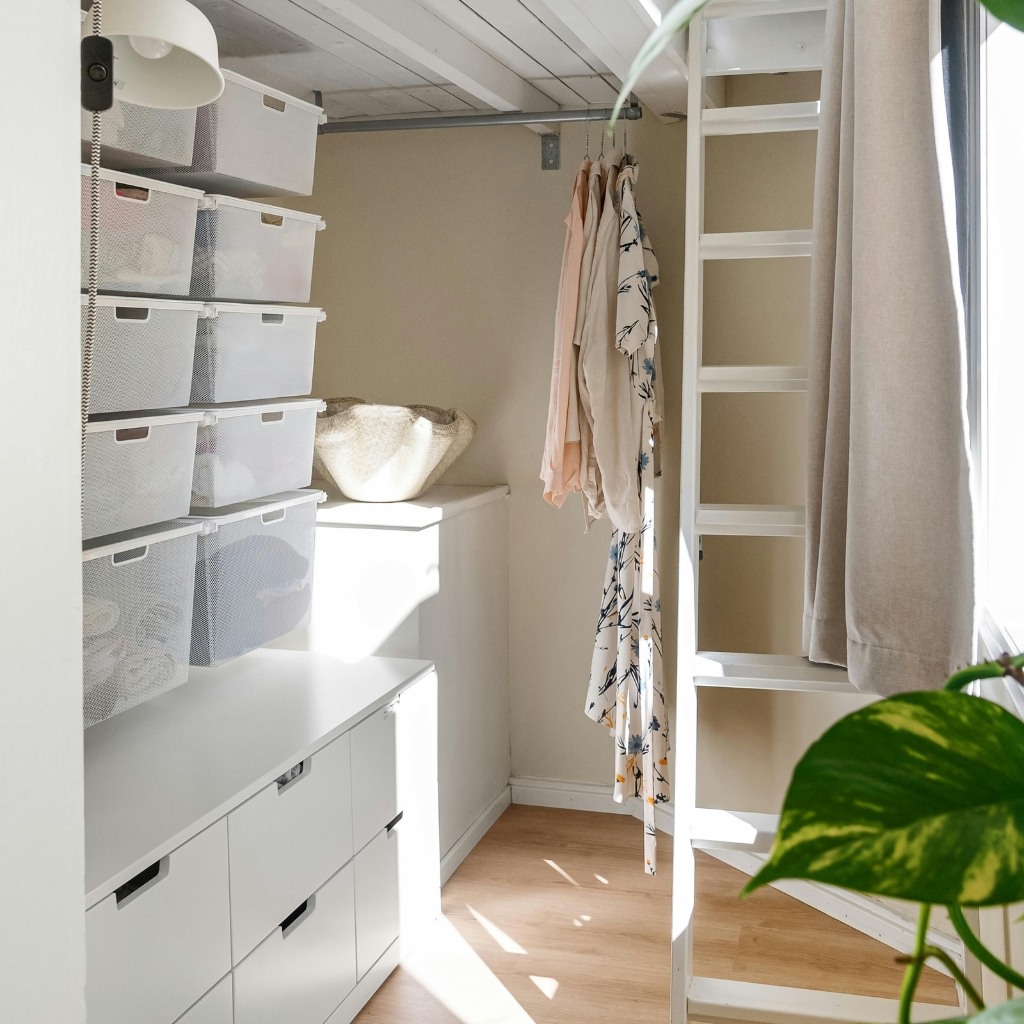Innovative loft storage ideas marry aesthetics with functionality, utilizing built-in drawers, custom shelving, and strategic placements under eaves to optimize spaces. These clever under-eaves storage solutions seamlessly integrate into sloped ceilings and small nooks, enhancing their utility and visual appeal with floating shelves.
Designed to maximize every inch of space while maintaining an uncluttered ambiance, these ideas promise style and practicality. Explore further to uncover additional creative approaches to transform your loft efficiently — especially when planning complementary features like a loft conversion with an ensuite for the perfect bathroom suite.
Key Takeaways
- Utilize built-in drawers and custom shelving tailored to fit sloped ceilings and eaves for efficient space use.
- Install floating shelves at various heights to optimize and enhance the aesthetic appeal of loft areas.
- Incorporate sliding doors on wardrobes and storage units to save space while maintaining easy access to stored items.
- Opt for multifunctional furniture such as ottomans with storage and convertible desks to maximize floor space and functionality.
- Apply high-performance insulation materials to ensure energy efficiency while integrating storage solutions seamlessly into the loft design.
How Can I Maximize My Attic Space Efficiently?
Maximizing attic space in small lofts demands innovative solutions for maximizing storage space that blends functionality with aesthetic appeal. Whether you’re planning a loft bedroom or designing attic rooms for multiple uses, smart planning is essential.
Utilizing smart storage options like loft eaves storage ideas or fitted cabinets can transform the area into a practical, stylish environment. These attic conversion storage ideas ensure that the space remains functional and beautiful.
For attics with sloped ceilings, clever solutions such as built-in drawers, storage for loft conversion, or custom shelving units make the most of the space beneath the eaves. These tactics help maximize space while maintaining a modern, clutter-free loft feel.
The goal is to maximize storage without sacrificing style—proving that even the most compact attic rooms can become elegant, livable spaces when equipped with well-designed storage features.
What Are the Best Storage Solutions for Small Lofts
Innovative storage solutions are essential for small lofts where every inch counts.
To optimize the available space effectively, it’s vital to implement strategic, visually appealing, and innovative loft conversion storage ideas.
Here are three key solutions:
- Eaves Storage: Tailor-made drawers and cupboards that fit into the sloping parts of the loft maximize every available corner, creating much-needed extra space without cluttering the area.
- Under-bed Storage: Utilize beds with built-in storage or add stylish, sliding drawers underneath to stealthily store items, enhancing functionality and aesthetic appeal.
- Storage Furniture: Opt for multifunctional furniture pieces such as ottomans with storage or convertible desks that save space and add a modern touch to the small loft’s decor.
How to Utilize Vertical Space in a Loft Conversion
How do loft dwellers fully exploit the often-overlooked dimension of their spaces? In loft conversions, maximizing this dimension is essential for enhancing storage capacity while maintaining aesthetic appeal.
Implementing built-in storage solutions that align with sloping ceilings can transform dead zones into useful areas. These are especially important when designing a habitable room, where every inch matters and safety must meet building regulations. Sliding doors on wardrobes guarantee accessibility without sacrificing more space, especially around features like chimney breast fireplaces or sloped walls.
Floating shelves add a modern touch and can be installed at varying heights to accommodate frequently accessed items. At the same time, custom cupboards or modular units around chimney breast fire areas can provide cleverly hidden storage. For more flexible solutions, well-placed freestanding furniture and under-eaves baskets offer style and function.
Those pursuing a basic loft conversion for storage can start small with durable cardboard boxes and labeled bins. However, the space is being developed into a habitable room. In that case, you’ll need to determine your needs carefully and potentially work with a contractor to ensure all design features align with planning permission requirements.
Whether working with a simple loft design or aiming for a high-end finish, a thoughtful layout and clever use of the vertical dimension make loft conversion storage practical and stylish. A good storage strategy can break up large wall areas and create usable niches without overcrowding.
| Storage Solution | Benefits | Best For |
| Floating Shelves | Aesthetic appeal; easy to install | Decorative items, books |
| Sliding Doors | Space-saving; sleek design | Wardrobes, cupboards |
| Storage Drawers | Optimizes lower vertical spaces | Seasonal clothing, shoes |
These methods increase the practicality of angled ceilings and contribute to a contemporary and uncluttered loft ambiance.
Creative Storage Ideas for Attic Sloped Ceilings
While tackling attic sloped ceilings, homeowners can discover unique opportunities to enhance functionality and style.
The distinctive angles of sloped ceilings in an attic conversion offer an aesthetic that can be harmoniously aligned with space-efficient storage solutions. The attic space transforms into a highly efficient and visually appealing area by focusing on tailor-made installations.
- Install Custom-Built Shelving: Maximize the storage potential by installing custom-built storage units that fit snugly under the eaves, turning awkward corners into functional assets.
- Utilize Retractable Drawers: Integrate retractable drawers in the loft eaves storage, providing easy access and ideal use of available space.
- Incorporate Multifunctional Furniture: Incorporate multifunctional furniture, like benches with hidden storage or storage beds with built-in cabinets, to utilize every inch of the loft conversion.
What Are Some Smart Ways to Store Items in a Loft Conversion?
In loft conversions, integrating floating shelves enhances the aesthetic appeal and provides a seamless solution for additional storage without consuming valuable space. These shelves are especially useful in loft storage room ideas, where making the most of vertical and awkward areas is essential.
Sliding doors can be a sleek, modern choice that maximizes usable area by eliminating the swing space needed for traditional doors. This makes them ideal for bespoke wardrobes or built-in cupboards, particularly in lofts where awkward angles and varying shapes can challenge standard furniture.
Additionally, incorporating storage drawers under sloped ceilings or knee walls plays an essential role in utilizing every possible nook for storage, keeping the space organized and tidy. For example, drawers near the floor level are the perfect place to store Christmas decorations, seasonal equipment, or other belongings that aren’t needed regularly.
In most cases, a loft conversion focused on storage can be tackled DIY, particularly if you’re adding wood shelving or custom-built units that fit perfectly into unused eaves. Just be sure to cover your plans by assessing the weight capacity of walls and floors, especially if you’re storing heavier items.
Adding function doesn’t mean sacrificing style—add shelves that align with your design vision, whether minimal or rustic. A well-planned loft conversion for storage is a practical project that turns even the most limited attic into a highly functional and attractive space. For added inspiration, especially if you’re considering integrating culinary elements, explore these creative loft kitchen ideas to elevate your design.

How to Integrate Floating Shelves for Extra Storage
Maximizing space in loft conversions, floating shelves offer an elegant and practical storage solution that aligns with contemporary design trends. These clever storage options not only enhance the aesthetic of a loft room but also help de clutter the space, providing smart ways to utilize available areas without the bulk of traditional furniture.
Here are three strategic placements for floating shelves in your loft conversion:
- Above the Desk: Install floating shelves directly above a work desk to keep essential items within easy reach, creating a functional and streamlined workspace. This simple yet effective solution maximizes space and helps maximise storage by using the vertical area above the desk.
- Beside the Bed: Position shelving on the wall beside the bed for books and nighttime essentials, maintaining a clutter-free bedside area. This placement allows you to maximise space without compromising on style, offering more storage for personal items close to hand.
- Under the Eaves: Use awkward spaces under the eaves by fitting custom-sized shelves for an efficient storage option that feels intentionally designed. These often-overlooked areas can be transformed into functional storage zones, giving you more storage for seasonal items, sports equipment, or other belongings.
Floating shelves in these areas help in maximising storage space without taking up valuable floor space, making them perfect for those seeking a minimalist approach. If you’re looking for additional clever storage ideas, consider working on a DIY basis to build custom units that make the most of every inch.
For a truly efficient loft conversion, consider utilizing every corner—including spaces like chimney breast fireplaces—to maximise storage and keep the room feeling open and organized. This thoughtful approach can turn any loft into a stylish, functional retreat, giving you the storage you need while maintaining a modern aesthetic.
Can Sliding Doors Help in a Loft Storage Conversion
Integrating sliding doors into a loft conversion can dramatically enhance the space’s storage capability and overall aesthetic. Sliding doors are crucial in maximizing space within a loft storage conversion, offering a sleek, efficient way to access additional storage. Their ability to disappear into walls or overlay seamlessly against them makes them particularly suitable for the often compact dimensions of a loft conversion space.
| Feature | Benefit | Aesthetic Impact |
| Space-saving | Maximizes usable area | Clean, uncluttered look |
| Accessibility | Easy access to items | Smooth, modern lines |
| Customization | Tailored to fit unique spaces | Integrates with decor |
What Role Do Storage Drawers Play in Maximizing Storage Space
While doors offer an elegant solution for accessing and concealing loft storage, incorporating storage drawers into the design further refines the functionality and style of the space.
Storage drawers are critical in maximizing space in a loft storage room conversion. Here are three ways they enhance the use of the available space:
- Efficient Organization: Storage drawers create dedicated compartments for various items, enabling better organization and easy retrieval, utilizing every inch of the loft conversion effectively.
- Preservation of Floor Space: Integrating storage drawers in areas like under beds or within staircases provides adequate storage while conserving valuable floor space.
- Aesthetic Appeal: Storage drawers can be designed to complement the interior aesthetics, adding a touch of sophistication while serving a practical storage purpose.
How to Make Use of Eaves Storage in a Loft Conversion?
Incorporating eaves storage into a loft conversion seamlessly combines form and function, transforming underutilized spaces into stylish, efficient storage solutions. For those seeking inspiration on how to make the most of sloped areas, loft conversion eaves storage ideas offer a wide range of options to suit different tastes, budgets, and layouts.
Custom-built storage furniture can be tailored to fit snugly into these angular nooks, utilize awkward corners, and work around the existing architecture—maximizing every available inch while maintaining a modern aesthetic. Whether dealing with tricky stairs or limited space, a smart layout is key to keeping your possessions accessible and safely stored.
Exploring built-in options such as drawers, cabinets, or shelving systems guarantees a clutter-free environment that enhances the loft space’s usability and appeal. Items rarely used, like extra cushions, off-season bags, or decorative display pieces, can be tucked away in stacked compartments or shelves.
Some clients may prefer hidden storage that blends with the room’s color scheme, while others might invest in visually appealing solutions that pop as design features. Alternatively, open shelving can highlight items and add personality to the space.
To achieve the best outcome, it’s often worth working with a professional team who can handle the job precisely, ensuring your loft conversion eaves storage works seamlessly with your overall interior design. You can also draw ideas from other smart home upgrades, like how to transform a bathroom on a budget to bring practicality and style into the space.
What Are Effective Ways to Utilize Eaves Space
Maximizing the eaves space in a loft conversion not only optimizes underused areas but also enhances the aesthetic appeal of the room. When planning your loft design, handling the eaves carefully is important, as poorly utilized space can lead to issues later on.
When considering how to utilize this unique area effectively, one can employ innovative storage solutions that transform the space into a functional and trendy loft element. This article offers valuable information and a helpful guide to make the most of your loft eaves while avoiding common pitfalls that can be expensive or difficult to resolve after installation. You may also find inspiration by exploring creative conversion ideas that apply similar space-maximizing principles to other parts of your home.
Built-in Drawers and Cupboards: Install custom-built drawers and cupboards that fit snugly into the eaves, giving your loft a clean, cohesive look while maximizing floor space. It’s a great way to create hidden storage that doesn’t interfere with the room’s layout.
Pull-out Boxes: Utilize sliding boxes on tracks or under eaves, which can be accessed and tucked away when not used. These are particularly effective for storing seasonal products, clothes, or things that aren’t used daily.
Tiered Shelving: Erect tiered shelves that follow the slope of the roof. These offer a beautiful and functional solution for books, decor, or storage baskets and change how the space feels by adding dimension and personality.
If you’re ready to buy materials or invest your time in a DIY build, consider this a smart step toward better organization. Various prefabricated and custom options are available to suit different styles and budgets.
Before you begin, plan carefully and consider your experience level—some installations may require expert help. Doing it right the first time can save you both time and money in the long run.
How Can Storage Furniture Enhance Loft Conversion Storage Ideas
Integrating storage furniture into a loft conversion can profoundly enhance the space’s functionality and aesthetics.
Freestanding units and bespoke designs tailored to the loft conversion room’s unique dimensions can transform previously unused areas into valuable storage spaces, minimizing clutter and maximizing room utility. Handy, strategically placed shelves keep essentials at arm’s reach while contributing to a tidy environment.
This space-saving approach meets diverse storage requirements without compromising the room’s style. The careful selection of furniture—considering material, color, and form—can also reflect current trends, ensuring the loft remains not only organized but also visually appealing.
Such thoughtful incorporation of storage furniture elevates a simple loft conversion into a seamlessly integrated, efficient living space.
What Built-In Storage Options Work Best for Loft Conversions
Several built-in storage options are ideally suited for loft conversions, particularly the use of eaves storage to utilize awkward spaces under the sloping roof effectively.
Every inch of floor area counts in bespoke lofts, making tailored solutions essential for maximizing space.
Custom Shelving: Install shelves that follow the contours of the eaves, turning unusable nooks into a design feature.
Pull-out Drawers: These can be hidden within the eaves, providing large, easily accessible storage without impeding the aesthetic of the newly converted loft.
Built-in Wardrobes: Fitted against sloping walls, these wardrobes maximize storage and maintain a sleek look, seamlessly integrating into the structure of the loft storage room.
London specialists offer expertly crafted, space-saving designs for homeowners looking for premium solutions under eaves cabinets that elevate functionality and style in urban loft conversions.
Are There Loft Storage Ideas That Cause Minimal Disruption?
For those seeking to enhance their loft with minimal disruption, DIY tips offer a cost-effective approach to integrating sleek, hidden storage solutions. Whether you’re just beginning the process or planning a full upgrade, the right strategy can deliver convenience and visual appeal.
Homeowners can declutter their space by focusing on concealed compartments and multifunctional furniture while maintaining a modern aesthetic. These loft conversion ideas storage solutions are especially useful for attics that serve multiple functions, offering a smart combination of practicality and style.
This trend-aware strategy not only optimizes living areas but also aligns with contemporary design preferences. For example, incorporating a skylight can illuminate the space naturally, highlighting smart storage without taking up extra room. Flexible options like foldaway furniture or built-ins that open toward the landing can provide additional utility in tighter layouts.
Homeowners should remember that some projects may require planning permission, particularly when altering structural elements or expanding usable space. Before you begin, it’s important to determine your goals—whether you’re purchasing materials for a weekend project or working with a professional to ensure a complete solution.
Creating functional storage that can handle regularly used items is key to the success of any loft conversion. Consider loft ideas storage like under-eaves drawers or vertical shelving for items you access frequently, while reserving hidden areas for seasonal items.
With the right plan and schedule, even a small loft can become the perfect blend of form and function—don’t forget to enjoy the shopping process along the way!

What Are Some DIY Loft Conversion Tips for Storage
Many homeowners are turning to DIY loft conversion storage solutions that blend functionality with modern aesthetics, ensuring every square inch serves a purpose without extensive renovations.
- Optimize Vertical Space: Utilize the height of smaller lofts by installing floor-to-ceiling shelving units. This basic yet effective type of storage maximizes every inch of available space for storage purposes, from books to clothes storage, without consuming valuable floor space.
- Under-eaves Cabinets: Tailor storage solutions to fit under the sloped ceilings of a loft. These custom cabinets provide additional space and keep the area tidy and streamlined.
- Multifunctional Furniture: Choose pieces like ottomans and beds with built-in storage. These save space while maintaining a chic, uncluttered environment.
How to Create Hidden Storage Spaces in a Loft Conversion
Building on the principles of effective use of space, creating hidden storage areas within a loft conversion can greatly enhance the functionality of this living area without major disruptions.
Utilizing the sloped ceilings typical in lofts, innovative storage ideas like built-in drawers or sliding panels can be seamlessly integrated to avoid wasted space, preserving the aesthetic while maximizing space. These solutions declutter the house and keep seasonal clothing out of sight and orderly.
Additionally, incorporating insulation into these hidden compartments can contribute to reducing energy bills, making the loft conversion not just trend-aware but also energy-efficient.
How can storage solutions also reduce energy bills?
Integrating energy-efficient features into loft storage designs enhances aesthetics and reduces utility costs. Making the best use of space under the roofline is especially important when aiming for functionality and sustainability.
Ideal insulation techniques, when paired with strategic ventilation, can transform a loft into a thermal-efficient space—allowing the area to remain comfortable across every season. Before you proceed, checking building requirements and insulation standards to ensure compliance is essential.
Selecting materials that align with modern energy standards guarantees these conversions are stylish and sustainable. In homebuilding, this means choosing eco-friendly insulation and air-sealing practices that bring long-term savings. Depending on your view of cost versus comfort, the right approach can also increase the value of your home.
For homeowners struggling to understand where to start, it helps to discuss your plan with a renovation director or energy consultant. A solid understanding of ventilation and airflow will support long-term success, especially when creating a storage loft conversion that will be used regularly.
In many cases, setting realistic goals and a timeline is helpful before moving forward with any installations. Whether your goal is to store plenty of seasonal items or create a more organized area, taking the long view helps ensure the finish aligns with your lifestyle.
If your attic is relatively open, consider installing energy-efficient windows that provide light while reducing heat loss. And always remember: when designing for energy efficiency, taking smart early steps helps guarantee comfort for years to come.
What Are the Best Insulation Practices for Loft Conversions
Why should loft conversions skimp on insulation when it’s a key factor in energy efficiency and aesthetic integration?
Proper loft insulation guarantees a comfortable living environment in your newly designed bedroom loft. It greatly reduces heating costs, making it a pivotal feature in maximizing space and enhancing property value.
- Choose High-Performance Materials: Opt for insulation materials like spray foam or rigid foam boards that offer superior thermal resistance and seamlessly integrate into the loft design without compromising space.
- Seal All Gaps: Confirm that every crevice, nook, and corner is airtight, particularly around windows and the ceiling, to prevent heat loss and maintain a consistent temperature.
- Layered Insulation: Implement a multi-layered approach by combining batt insulation with loose fill to optimize energy conservation and soundproofing, transforming your loft conversion into a serene, energy-efficient retreat.
How Does Proper Ventilation Impact Energy Efficiency
After addressing the importance of robust insulation in loft conversions, it’s equally important to contemplate how ventilation plays a role in maintaining energy efficiency.
Proper ventilation in a loft conversion is crucial for maximizing space and ensuring a comfortable, energy-efficient environment.
Innovative storage ideas that integrate ventilation solutions can prevent the buildup of moisture and heat, which, if left unchecked, can lead to increased energy usage and higher bills.
By facilitating a steady flow of air, these storage designs help maintain a balanced temperature, reducing the need for artificial heating and cooling.
This strategic approach not only impacts the overall energy efficiency of the loft but also enhances the longevity and usability of the space, making it a smart, trend-aware choice for homeowners.
What Are the Most Energy-Efficient Materials for Loft Conversions
Selecting the most energy-efficient materials for loft conversions is key to reducing energy bills while optimizing the aesthetics and functionality of the space. When transforming an attic into a vibrant living space, the choice of materials can greatly influence both the cost and the energy efficiency of the new loft conversion.
Insulation: Superior insulation materials like spray foam or rigid panels maintain the desired temperature with minimal disruption and maximize head height, making the space feel larger. It’s wise to assess the insulation’s energy performance rating—often indicated by a label—to ensure it effectively supports year-round comfort.
Windows: Energy-efficient glazed windows reduce heat loss, ensuring the loft is comfortable without excessive heating costs. They also enhance both the amount of space and light. Choosing frames that match the style of your home can increase visual cohesion while allowing for plenty of natural daylight throughout the day.
Flooring: Using sustainable, insulating materials for flooring can help retain heat, making the loft a cozy retreat and effectively utilizing every measure of space. In addition to energy performance, consider how well the flooring fits into your storage ideas for attic conversion, such as hidden compartments or raised platforms that add utility without sacrificing style.
Whether upgrading an existing space or starting fresh, selecting materials that deliver on performance and appearance is always wise. With the right planning and product selection, your loft can become a comfortable, energy-efficient living area that complements your home.
Conclusion
To sum up, transforming a loft into an efficient, aesthetically pleasing storage area to accommodate your daily routine requires creativity and an awareness of modern trends. By utilizing smart solutions like eaves storage and bespoke built-ins, homeowners can maximize this underutilized space without causing significant disruption.
For example, under eaves storage London projects often showcase how tailored solutions can adapt perfectly to the unique architecture of older or urban homes, making the most of awkward angles while maintaining sleek aesthetics.
Additionally, integrating energy-efficient features into storage designs not only optimizes space but also contributes to lower energy bills, merging functionality with sustainability in a stylish, contemporary home.















